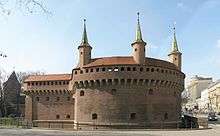Barbican
A barbican (from Old French: barbacane) is a fortified outpost or gateway, such as at an outer defence perimeter of a city or castle, or any tower situated over a gate or bridge which was used for defensive purposes.


Barbicans were typically situated outside the main line of defences and were connected to the city walls with a walled road called the neck.[1] In the 15th century, with the improvement in siege tactics and artillery, barbicans lost their significance.[2] However, several barbicans were built even in the 16th century.
Fortified or mock-fortified gatehouses remained a feature of ambitious French and English residences well into the 17th century.
Fortifications in East Asia also feature similar high structures. In particular, gates in Chinese city walls were often defended by an additional "archery tower" in front of the main gatehouse, with the two towers connected by walls extending out from the main fortification. Literally called "jar walls", they are often referred to as "barbicans" in English.[3]
See also
- Barbican Estate, London[4]
- Barbican, Plymouth
- Gatehouse
- Kraków barbican
- Warsaw Barbican
- Saint Laurence Gate, Drogheda
References
- "Castle Barbican". medievalchronicles.com. medievalchronicles. Retrieved 12 July 2019.
- "Castle Architecture - Gateways & Barbicans". www.castlesandmanorhouses.com. Retrieved 12 July 2019.
- Quan, Yuan. "New realities 'rebuild' Beijing's lost city gates". China Daily. Retrieved 12 July 2019.
- "6 images that show what it's like to live in one of the world's most famous buildings". The Independent. 26 November 2016. Retrieved 12 July 2019.
- "Barbican Estate history". City of London. Retrieved 12 July 2019.
- "Castle Architecture - Gates". Castles and Man or Houses. Retrieved 12 July 2019.</ref>
External links
| Look up barbican in Wiktionary, the free dictionary. |

- . Encyclopædia Britannica. 3 (11th ed.). 1911.
- Barbican at Location Textures
- Barbican, A Fortified Outpost Of Old Town Of Krakow, Poland on DreamSite
- Parts of Medieval Castles
- Krakow Barbican – The Last Remains of the City’s Medieval Defences on Absolute Tours
- Barbican on Encyclopædia Britannica
- Castle Barbican on Medieval Chronicles
- Barbican on Ancient Fortresses